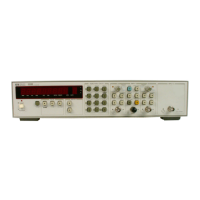8-190. Each interpolator has an
8
pA
current source and a
2
mA
current sink to charge and discharge an exter-
nal capacitor. The duration of each
ST1 and SPI pulses between
100
and
200
nanoseconds. The interpolators ex-
pand the MRC pulses by a factor of
200
via the capacitors. The expanded
20
to
40
microsecond pulses (STIC
and SPIC) are used to gate the 10 MHz time base signal (OSCI) through an internal NAND gate. The resulting
10 MHz
Tm
pulse streams (ST10 and SPIO) from the interpolators are input directly to the START and STOP
Interpolator Counters.
8-191. The MRC controls the START and STOP Interpolator Counters by clearing the counters with the event
register reset (ERR)
lime when the MRC
is
reset. The dual, Cbit binary counters (U12 and U13) are clocked by
the falling edge of each incoming pulse from the MFC. The count accumulated in the
ST1 and SPI counters will
proportionally reflect the length of each pulse stream. When
directed by the Measurement MCU, quad 2-to-1
multiplexers, U15 and U16, transfer the interpolation data to the Measurement Data Bus. Data transfer is con-
trolled by the SELECT line and the OUTPUT ENABLE
line.
8-192. A typical Measurement Block cycle executes by inputting the unknown signal and the Time Base to
MRC U20 where they are accumulated, counted, and stored as raw measurement data in the
MRC's registers.
At the same time, the MRC provides START and STOP Interpolator pulses to MFC
U14BlC. These pulses rep-
resent the gate error factor caused by the phase difference between the unknown signal and the Time Base
reference. Along with the error pulse, the MRC outputs calibration pulses of exactly 100 and
200
nanoseconds.
8-193. Each pulse is expanded and converted to a pulse stream in the MFC and sent to Interpolator Counters
U12 and U13. The count data is multiplexed onto the Measurement Data Bus when called for by the Measure-
ment MCU. The MCU uses the error and calibration count to determine the time length of the measurement
error.
8-194. When the measurement is complete, the Measurement MCU reads the data from the MRC's registers,
and the data from the Interpolator Counters. The MCU then performs the necessary calculations to determine
the result for the selected function mode. For example, in a frequency measurement, the MCU adjusts the value
for T (the Time Base data) to compensate for the error measured by the Interpolator Counters. The value for E,
the unknown frequency count, is then divided by the modified T value to determine the frequency. Likewise,
dividing T by
E
would determine the period of the measurement.
The number of accumulated clock pulses combined with the interpolator adjustments is multiplied by the
10 MHz reference clock period to compute TIME:
TIME
=
(T count
+
ST1 adjustment
-
SPI adjustment
)
x
(100ns)
To determine frequency, the MRC EVENT register count is divided by the computed TIME:
Frequency
=
EVENTS/TIME
A period measurement is determined by computing:
Period
=
TIMEEVENTS
8-195. The measurement data is then interpreted by the Executive MCU, formatted and sent over the Execu-
tive Data Bus to the front panel display and the HP-IB MCU.
HP
5334B
-
Service Manual
8-27

